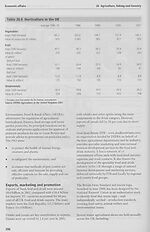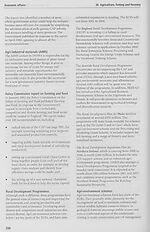Download files
Complete book:
Individual page:
Thumbnail gallery: Grid view | List view

Economic affairs
26 Agriculture, fishing and forestry
■ the Royal Show, Stoneleigh, Warwickshire
(early July), enabling visitors to see the latest
techniques and improvements in British
agriculture - some 151,000 visitors attended
in 2002;
■ the Royal Highland Show, Edinburgh (June),
with around 4,000 head of livestock on show
and the largest trade exhibition of
agricultural machinery in Great Britain -
168,000 visitors in 2002;
■ the Royal Welsh Show, Llanelwedd, Builth
Wells (late July);
■ the Royal Welsh Agricultural Winter Fair,
Llanelwedd, Builth Wells, for livestock and
carcases (December);
■ the Royal Ulster Agricultural Society Show,
Belfast (May); and
■ the Royal Smithfield Show, London (every
other year), for agricultural machinery,
livestock and carcases.
Government role
The Department for Environment, Food & Rural
Affairs (DEFRA) has a crucial role in promoting
sustainable development, rural renewal, and
sustainable and competitive food chains, both in
England and internationally. It has responsibility
for agriculture, fisheries, food, animal welfare
issues, environmental protection, and wildlife and
the countryside in general. DEFRA administers
support policies agreed in Brussels which provide
around £3 billion a year to UK agriculture from
the European Union (EU) budget.
The Scottish Executive Environment and Rural
Affairs Department (SEERAD), the National
Assembly for Wales Agriculture Department
(NAWAD), and the Department of Agriculture
and Rural Development in Northern Ireland
(DARD) have varying degrees of responsibility for
agriculture and fisheries affairs. Matters not
devolved or transferred to the devolved
administrations, such as relations with the EU and
other international organisations, remain with the
Government in London. The work of DEFRA’s
nine Regional Service Centres in England and
SEERAD’s eight areas in Scotland relates to
payments under domestic and EU schemes,
licensing and other services for farmers and
growers.
UK agriculture strategy
The Government’s aim is to secure a more
competitive agriculture industry with a stronger
market orientation. In A New Direction for
Agriculture - published in 1999 - it set out its
long-term strategy for the future development of
the industry. The strategy is designed to help
farming become more competitive, diverse,
flexible, responsive to consumer wishes and
environmentally responsible. It aims to deliver
short-term support to those sectors hit hardest by
the continuing farming crisis and longer-term
action to encourage industry restructuring and
adaptation.
Rural Development Programmes (RDPs) (see page
398) are helping to implement the strategy,
investing nearly £3 billion in the UK rural
economy from 2001 to 2006.
The RDPs have been supplemented by other
measures, in particular the Action Plan for
Farming, launched in March 2000 in response to
the crisis in farm incomes in the UK. The plan
provides short-term financial relief and longer-
term support for business restructuring and
development, improved marketing and food chain
co-operation, training and innovation. Although a
number of measures in the Action Plan are UK¬
wide, others are focused on England. The
devolved administrations are developing strategies
to meet priorities in their own areas. The Scottish
Executive published a policy document, A forward
strategy for Scottish agriculture, in June 2001, and
the Welsh Assembly published its strategy for
farming in Wales, Farming for the future, in
November 2001. A Vision for the future of the
Northern Ireland agri-food industry, produced by
the ‘Vision’ group set up by the Minister of
Agriculture and Rural Development, was
published in October 2001.
The milk task force
Set up in 2000 by the then Ministry of Agriculture,
Fisheries and Food to study and report on the
food chain in the milk and dairy sector, the task
force was asked to identify those areas where
greater efficiencies could be obtained from
production and marketing. It published its report
in January 2002. The report states the need for
greater co-operation and communication between
participants in the dairy supply chain, for example
in market and scientific research, the promotion
of milk and milk products, and the collection and
distribution of milk.
397
26 Agriculture, fishing and forestry
■ the Royal Show, Stoneleigh, Warwickshire
(early July), enabling visitors to see the latest
techniques and improvements in British
agriculture - some 151,000 visitors attended
in 2002;
■ the Royal Highland Show, Edinburgh (June),
with around 4,000 head of livestock on show
and the largest trade exhibition of
agricultural machinery in Great Britain -
168,000 visitors in 2002;
■ the Royal Welsh Show, Llanelwedd, Builth
Wells (late July);
■ the Royal Welsh Agricultural Winter Fair,
Llanelwedd, Builth Wells, for livestock and
carcases (December);
■ the Royal Ulster Agricultural Society Show,
Belfast (May); and
■ the Royal Smithfield Show, London (every
other year), for agricultural machinery,
livestock and carcases.
Government role
The Department for Environment, Food & Rural
Affairs (DEFRA) has a crucial role in promoting
sustainable development, rural renewal, and
sustainable and competitive food chains, both in
England and internationally. It has responsibility
for agriculture, fisheries, food, animal welfare
issues, environmental protection, and wildlife and
the countryside in general. DEFRA administers
support policies agreed in Brussels which provide
around £3 billion a year to UK agriculture from
the European Union (EU) budget.
The Scottish Executive Environment and Rural
Affairs Department (SEERAD), the National
Assembly for Wales Agriculture Department
(NAWAD), and the Department of Agriculture
and Rural Development in Northern Ireland
(DARD) have varying degrees of responsibility for
agriculture and fisheries affairs. Matters not
devolved or transferred to the devolved
administrations, such as relations with the EU and
other international organisations, remain with the
Government in London. The work of DEFRA’s
nine Regional Service Centres in England and
SEERAD’s eight areas in Scotland relates to
payments under domestic and EU schemes,
licensing and other services for farmers and
growers.
UK agriculture strategy
The Government’s aim is to secure a more
competitive agriculture industry with a stronger
market orientation. In A New Direction for
Agriculture - published in 1999 - it set out its
long-term strategy for the future development of
the industry. The strategy is designed to help
farming become more competitive, diverse,
flexible, responsive to consumer wishes and
environmentally responsible. It aims to deliver
short-term support to those sectors hit hardest by
the continuing farming crisis and longer-term
action to encourage industry restructuring and
adaptation.
Rural Development Programmes (RDPs) (see page
398) are helping to implement the strategy,
investing nearly £3 billion in the UK rural
economy from 2001 to 2006.
The RDPs have been supplemented by other
measures, in particular the Action Plan for
Farming, launched in March 2000 in response to
the crisis in farm incomes in the UK. The plan
provides short-term financial relief and longer-
term support for business restructuring and
development, improved marketing and food chain
co-operation, training and innovation. Although a
number of measures in the Action Plan are UK¬
wide, others are focused on England. The
devolved administrations are developing strategies
to meet priorities in their own areas. The Scottish
Executive published a policy document, A forward
strategy for Scottish agriculture, in June 2001, and
the Welsh Assembly published its strategy for
farming in Wales, Farming for the future, in
November 2001. A Vision for the future of the
Northern Ireland agri-food industry, produced by
the ‘Vision’ group set up by the Minister of
Agriculture and Rural Development, was
published in October 2001.
The milk task force
Set up in 2000 by the then Ministry of Agriculture,
Fisheries and Food to study and report on the
food chain in the milk and dairy sector, the task
force was asked to identify those areas where
greater efficiencies could be obtained from
production and marketing. It published its report
in January 2002. The report states the need for
greater co-operation and communication between
participants in the dairy supply chain, for example
in market and scientific research, the promotion
of milk and milk products, and the collection and
distribution of milk.
397
Set display mode to:
![]() Universal Viewer |
Universal Viewer | ![]() Mirador |
Large image | Transcription
Mirador |
Large image | Transcription
The item on this page appears courtesy of Office for National Statistics and may be re-used under the Open Government Licence for Public Sector Information.
| Britain and UK handbooks > UK: The official yearbook of the United Kingdom of Great Britain and Northern Ireland > 2003 > (443) |
|---|
| Permanent URL | https://digital.nls.uk/204928872 |
|---|
| Attribution and copyright: |
|
|---|---|
| Description | Three volumes of 'UK: The official yearbook of the United Kingdom of Great Britain and Northern Ireland', published annually by the Office of National Statistics from 2002-2005. |
|---|---|
| Shelfmark | GII.11 SER |
| Description | Three titles produced by the British Government from 1954-2005 describing 'how Britain worked'. They are: 'Britain: An official handbook' (1954-1998), 'Britain: The official yearbook of the United Kingdom' (1999-2001), and 'UK: The official yearbook of the United Kingdom of Great Britain and Northern Ireland' (2002-2005). These 50 reports provide an overview of Britain's economic, social and cultural affairs, its environment, international relations, and the systems of government. They give an impartial summary of government policies and initiatives, and explain how public services are organised. |
|---|---|
| Additional NLS resources: |
|

